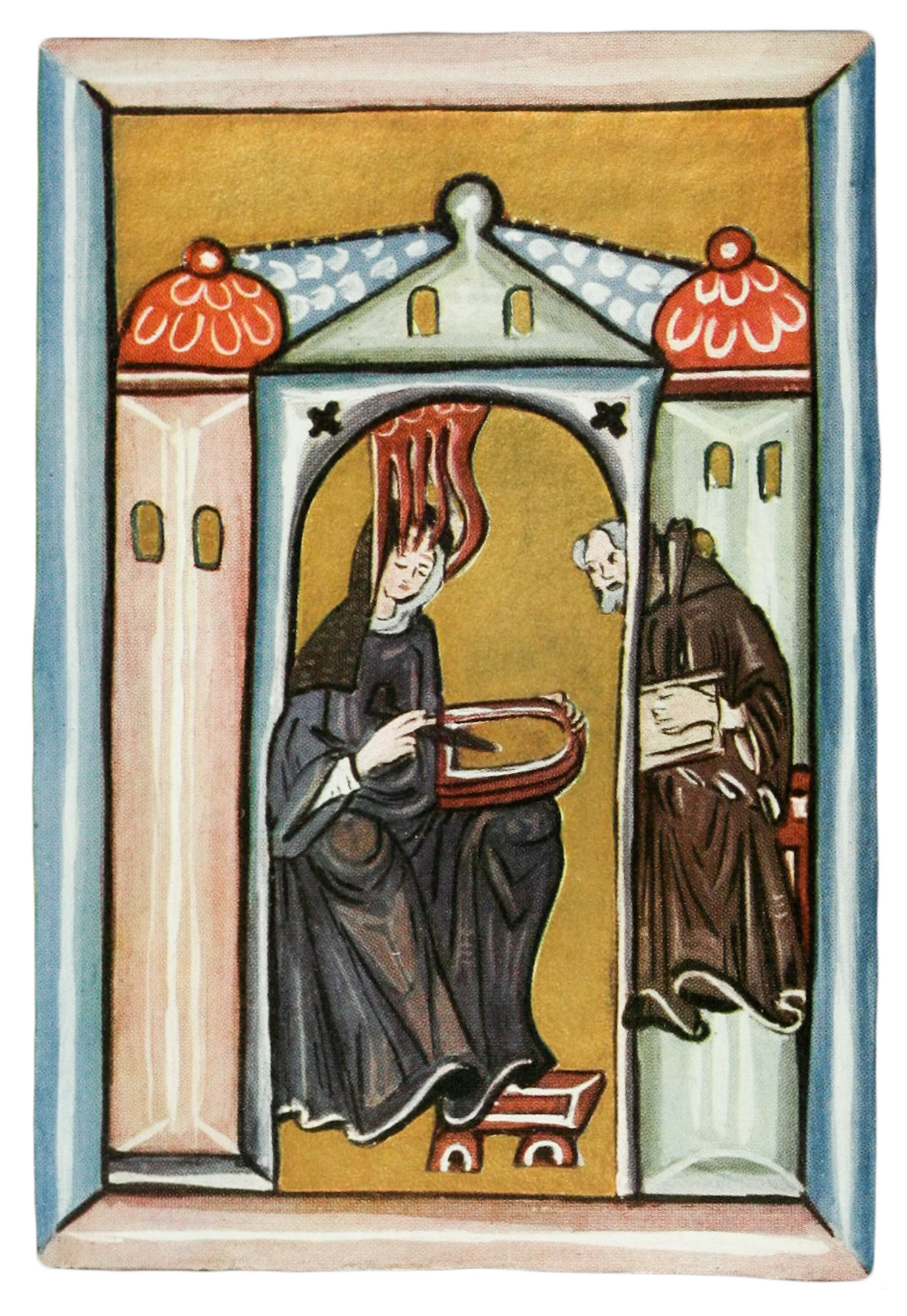One On One: Sriwhana Spong on Hildegard of Bingen
By Sriwhana Spong
Full text also available in Chinese.

Illustration from the Rupertsberg manuscript of Scivias (c.1151/1152) by Hildegard of Bingen.
As a child, the 12th-century German mystic Hildegard of Bingen (1098–1179 CE) was enclosed at the monastery Disibodenberg. The site of her enclosure, a hill about an hour by car from Frankfurt am Main, is today lush with vegetation and filled with birdsong. Perhaps it was like this back when she received her Lingua Ignota (“unknown language”), comprised of 1012 nouns, including names for flora (184), flying creatures such as birds, the bat, the gryphon (63), and parts of the body (120). With her new lexicon, she plucked out her eyes and inserted her luzpomphia, her word for “eyeball” that holds an apple (pomziaz), or more precisely, half an apple (pom), at its core. Most poignantly, she offers two meanings for zamzia: “land, one’s own” and “basement.” For our enclosed mystic, the basement is her land, and from it she builds a world where even God is erased and renamed Aigonz.
Hildegard had visions from a young age and began to document them when she was 42. She was encouraged in her efforts by the voice of Aigonz: “Cry out therefore, and write thus!” A commission of men was sent to investigate, and upon deciding that she was “competent” and “authentic,” her writing was granted papal approval. In 1148, Hildegard was inspired in a vision to found an abbey at Mount St. Rupert. During negotiations with the implacable Abbot Kuno of Disibodenberg, Hildegard was overcome by a paralyzing illness. This was, she insisted, because Aigonz’s instructions had been disobeyed. Outmaneuvered, the abbot relented, and Hildegard left her former place of internment in excellent health.
Hildegard’s visions were an aperture through which she escaped, taking her sisters with her. We read of “strange and irregular practices” at Rupertsberg through a letter written by Tengswich, the mistress of a foundation of canonesses: “They say that on feast days your virgins stand in the church with unbound hair when singing the psalms . . . Moreover, it is said that they wear crowns of gold filigree . . . And all this despite the express prohibition of the great shepherd of the Church, who writes in admonition: Let women comport themselves with modesty.”
Hildegard replied, addressing all women with the voice of Aigonz, whom she says speaks through her: “O, woman, what a splendid being you are! For you have set your foundation in the sun, and have conquered the world.”
I first encountered Hildegard’s work through the illuminations she supervised to accompany her book of visions, Scivias (completed 1151/52). She also composed music and wrote on botany, theology, and medicine. But it’s the Lingua Ignota that draws me in because it’s a way of gleaning a sense of her everyday through the things in the sublunary world that she noticed and revitalized with green, sapling words.
I was raised in a Christian fundamentalist environment—the US-American kind that came to Aotearoa in the 1980s. It was believed that this island country at the bottom of the world was the perfect place to await the Second Coming. I experienced the Christian religion as a force that separated, and I see in Hildegard’s Lingua Ignota an integrative impulse, one which renews her relationship to the world she was initially enclosed from. Her language (which it is believed she shared with her sisters) can be seen as a refusal of the (mis)translation of the world she was born into, the text that carved into her female body its sentence—passive-irrational-emotional-lustful-disordered—for which she was disciplined.
The job of naming, given by God to Adam—she steals it. She breaks into the official language of the Church with a private tongue, loosening the existing models that have caged her. She pries open Latin sentences, creating abscesses her life oozes into, while taking the adjectives and verbs needed to let her nouns move. Like a lover, she brings things close with a private name shared only between them, but marks the distance between them in the very act of naming. In this way, the Lingua Ignota is moved by the ceaseless oscillations of ecstatic intimacy and uncrossable distance that mark the mystical encounter and the practice it opens up.
Hildegard’s “strange and irregular” project enacts an errantry and produces a language entangled in the roots of a woman’s experience. It is a world-building through which she opens up the enclosure of language, creating new meanings and possibilities for herself and her sisters—a familiar drive despite the centuries and contexts that separate us.






